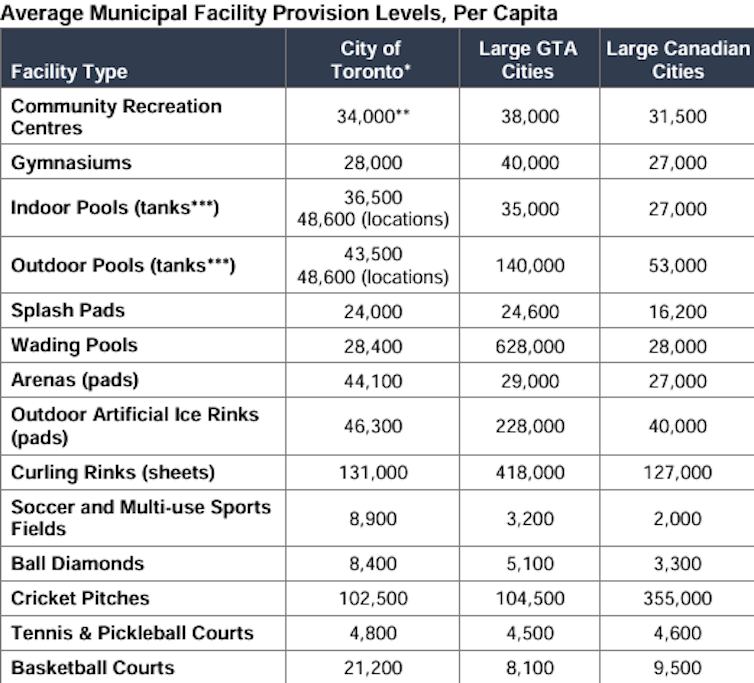In June, Ontario Premier Doug Ford abruptly announced that the Ontario Science Centre was closing permanently after engineers found structural issues with the building’s roof.
The closure sparked public outcry, as well as skepticism about the reasons behind it. In April 2023, Ford said the Science Centre would be moving to Ontario Place. However, in December, Ontario’s auditor general said that the province’s case for moving the science centre was “missing key information.”
We are not advocating for the Ontario Science Centre to close, however, as things stand, it seems unlikely it will be reopened at its current site. That raises the question: what should be built on the original site?
As researchers who study physical activity participation and inequities, we contend that the site is ideal for a multi-purpose, state-of-the-art sports complex.
Here are several reasons why.
Supporting the surrounding communities
Sport creates community. By bringing together diverse groups, sports allow residents to share their culture while learning about others. This fosters stronger social ties, encourages collaboration, and enhances mutual understanding and respect among diverse groups.
The two neighbourhoods near the science centre, Thorncliffe Park and Flemingdon Park, are some of the city’s most densely populated, lowest-income and diverse neighbourhoods. Yet, the two neighborhoods have only two small community recreation centres that offer, in total, one indoor pool, three weight rooms, one ice rink and two gymnasiums.
Community groups have voiced their concerns about the lack of recreation spaces in the neighbourhoods and the challenges of operating year-round sports programs.
Both areas are recognized by the city as “Neighbourhood Improvement Areas” where residents face serious inequities related to health, economics, political participation and education.
Building a state-of-the-art sports centre at the site would align with the vision of Toronto’s Parks & Recreation Facilities Plan. The plan’s aim is to address the shortage of sports facilities throughout the city.
The current provision rates per capita for various sports facilities are markedly lower than comparable cities in Canada.

Activities such as pickleball, badminton, volleyball and tennis are popular and fast-growing. But publicly accessible indoor spaces for these activities are limited. With the lack of facilities, many Torontonians, especially those in low-income areas cannot participate as easily.
In downtown Toronto, for example, with a population of about 276,000 people, there are only eight public gyms across seven community recreation centres.
That equates to about 34,500 people sharing one gymnasium. To put into perspective, one gymnasium can only accommodate 21 people for volleyball or 24 for pickleball/badminton, per the city’s drop-in program rules. For tennis, there are no public indoor facilities in downtown Toronto.
With its central location and the future opening of the Eglinton Crosstown LRT and construction of the Ontario Line subway — both including stops at the Science Centre — a sports facility at the science centre site would serve the needs of residents nearby and across Toronto, including the downtown core, where accessible year-round facilities are scarce.
The power of sports
Providing accessible sports opportunities through a sports centre is an effective intervention to help create a community that is more equitable socially and economically.
People who regularly exercise not only are physically healthier, but they are also more likely to be socially connected and civically active, engaging in activities like volunteering and voting.
They also often report better psychological well-being such as higher self-esteem and a sense of competency, leading to improved social outcomes such as mental health, education, economic stability and social mobility.
Sport is an important way for people to make friends, build connections within their community and find a sense of belonging. A high proportion of residents in the nearby neighbourhoods are new immigrants and racialized people. Sport can also often help newcomers adapt to the new environment, integrate into the society and thrive. Creating accessible sports opportunities can bring substantial improvement to people’s quality of life.
Canada’s physical activity crisis
Promoting physical activity has never been more important. Physical activity is in crisis in Canada. Extensive evidence shows that Canadians are not sufficiently active. A recent report by ParticipACTION, a national organization that monitors physical activity among Canadians, shows that only 27 per cent of Canadian adults participate in sports, and only 39 per cent of youth meet the recommended physical activity guideline.
Moreover, a recent study found that marginalized people who hold more than one socially disadvantaged identity (such as racialized people who are also immigrants) are significantly less likely to be active than others. Such disparities are often due to institutional factors such as systemic discrimination, facility access and socioeconomic constraints.
Building a sports centre in communities like Thorncliffe Park and Flemingdon Park is one concrete action the government can take to address this crisis.
All Canadians should have accessible year-round sports opportunities. Regular physical activity is key to health and prevent chronic diseases, including reduced risks of many types of cancer, depression and dementia and heart disease.
Having a year-round accessible indoor sports complex is thus imperative for Canadians’ health and well-being of communities.
Lastly, building a sports centre at the site would ensure it remains open to the public. And it would demonstrate that the provincial government and City of Toronto have the best interests of Torontonians in mind.
Chloe Sher receives funding from the Social Sciences and Humanities Research Council of Canada.
Caroline Fusco does not work for, consult, own shares in or receive funding from any company or organisation that would benefit from this article, and has disclosed no relevant affiliations beyond their academic appointment.
This article was originally published on The Conversation. Read the original article.







